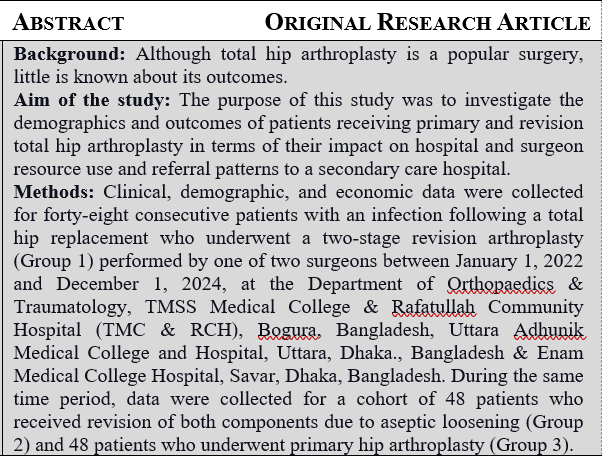Outcomes of Rivision of Total Hip Arthroplasty in Patients in Secondary Care Hospital
Abstract
Background: Although total hip arthroplasty is a popular surgery, little is known about its outcomes.
Aim of the study: The purpose of this study was to investigate the demographics and outcomes of patients receiving primary and revision total hip arthroplasty in terms of their impact on hospital and surgeon resource use and referral patterns to a secondary care hospital.
Methods: Clinical, demographic, and economic data were collected for forty-eight consecutive patients with an infection following a total hip replacement who underwent a two-stage revision arthroplasty (Group 1) performed by one of two surgeons between January 1, 2022 and December 1, 2024, at the Department of Orthopaedics & Traumatology, TMSS Medical College & Rafatullah Community Hospital (TMC & RCH), Bogura, Bangladesh, Uttara Adhunik Medical College and Hospital, Uttara, Dhaka., Bangladesh & Enam Medical College Hospital, Savar, Dhaka, Bangladesh. During the same time period, data were collected for a cohort of 48 patients who received revision of both components due to aseptic loosening (Group 2) and 48 patients who underwent primary hip arthroplasty (Group 3).
Results: Revisions for infection resulted in longer operational times, more blood loss, and more complications compared to revisions for aseptic loosening or original total hip arthroplasty (p < 0.02). Revisions for infection were linked to increased hospitalizations, days in the hospital, operations, costs, outpatient visits, and charges within a year of the index procedure (p < 0.001). Over a five-year period, our institution saw a significant increase in referrals for infection after total hip arthroplasty (Spearman rank correlation, 1.0; p = 0.0083). However, referral rates for revision for other reasons remained relatively constant (Spearman rank correlation, 0.500; p = 0.3910).
Conclusion: Infections after total hip arthroplasty require significantly more hospital and medical resources than revisions due to aseptic loosening or original total hip arthroplasty.
Downloads
References
Chang RW, Pellisier JM, Hazen GB. A cost effectiveness analysis of total hip arthroplasty for osteoarthritis of the hip. JAMA. 1996;275(11):858-865.
Katz JN, Phillips CB, Baron JA, et al. Association of hospital and surgeon volume of total hip replacement with functional status and satisfaction three years following surgery. Arthritis Rheum. 2003;48(2): 560-568.
Kurtz S, Mowat F, Ong K, Chan N, Lau E, Halpern M. Prevalence of primary and revision total hip and knee arthroplasty in the United States from 1990 through 2002. J Bone Joint Surg Am. 2005;87 (7):1487-1497.
National Center for Health Statistics. Health, United States, 2009: with special feature on medical technology. Centers for Disease Control and Prevention Web site. http://www.cdc.gov/nchs/data/hus/hus09.pdf. Accessed March 28, 2011.
Birkmeyer NJ, Marrin CA, Morton JR, et al; Northern New England Cardiovascular Disease Study Group. Decreasing mortality for aortic and mitral valve surgery in Northern New England. Ann Thorac Surg. 2000; 70(2):432-437.
Birrell F, Johnell O, Silman A. Projecting the need for hip replacement over the next three decades: influence of changing demography and threshold for surgery. Ann Rheum Dis. 1999; 58(9):569-572.
Huo MH, Parvizi J, Bal BS, Mont MA; Council of Musculoskeletal Specialty Societies (COMSS) of the American Academy of Orthopaedic Surgeons. What’s new in total hip arthroplasty. J Bone Joint Surg Am. 2008;90(9):2043-2055.
Ricciardi R, Virnig BA, Ogilvie JW Jr, Dahlberg PS, Selker HP, Baxter NN. Volume-outcome relationship for coronary artery bypass grafting in an era of decreasing volume. Arch Surg. 2008;143(4):338-344.
Ho V, Town RJ, Heslin MJ. Regionalization versus competition in complex cancer surgery. Health Econ Policy Law. 2007;2(pt 1):51-71.
Zwanziger J, Melnick GA. The effects of hospital competition and the Medicare prospective payment system program on hospital cost behavior in California. J Health Econ. 1988;7(4):301-320.
Sloan FA, Morrisey MA, Valvona J. Effects of the Medicare prospective payment system on hospital cost containment: an early appraisal. Milbank Q. 1988; 66(2):191-220.
Aii patient refined diagnosis reiated groups (APR-DRGs) version 15.0, definitions manual. Waiiingford, CT: 3M Heaith information Systems: 1998.
Lentino JR. Prosthetic joint infections: bane of orthopedists, challenge for infectious disease specialists. Ciin infect Dis. 2003:36:1157-61.
Ahnfeit L, Herberts p Maichau H, Andersson GB. Prognosis of total hip replacement. A Swedish muiticenter study of 4,664 revisions. Acta Orthop Scand Suppl. 1990:238:1-26.
Hanssen AD, Rand JA. Evaluation and treatment of infection at the site of a total hip or knee arthroplasty. instr Course Lect. 1999;48:lll-22.
Salvati EA, Gonzalez Deiia Valle A, Masri BA, Duncan CP The infected total hip arthroplasty. instr Course Lect. 2003;52:223-45.
Sharkey PF, Shastri S, Teioken MA, Parvizi J, Hozack WJ, Rothman RH. Relationship between surgical voiume and eariy outcomes of total hip arthroplasty: do resuits continue to get better? J Arthroplasty. 2004:19:694-9.
Scuico TP The economic impact of infected total Joint arthropiasty. instr Course Lect. 1993:42:349-51.
Hebert CK, Wiiiiams RE, Levy RS, Barrack RL. Cost of treating an infected total knee repiacement. Ciin Orthop Reiat Res. 1996:331:140-5
Barrack RL. Economics of the infected total knee repiacement. Orthopedics. 1996:19:780-2.
Finkier SA. The distinction between cost and charges. Ann intern Med: 1982: 96:102-9.
Katz PP Showstack JA, Lake JR, Brown RS Jr, Dudley RA, Colweii ME, Wiesner RH, Zetterman RK, Everhart J. Methods to estimate and anaiyze medical care resource use. An example from liver transplantation, int J Technoi Assess Heaith Care. 1999:15:366-79.



























